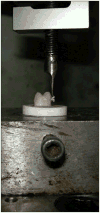In-vitro evaluation of an experimental method for bonding of orthodontic brackets with self-adhesive resin cements
- PMID: 24163808
- PMCID: PMC3806483
- DOI: 10.4103/2278-9626.116018
In-vitro evaluation of an experimental method for bonding of orthodontic brackets with self-adhesive resin cements
Abstract
Background: Self-adhesive resin cements do not require the surface treatment of teeth and are said to release fluoride, which makes them suitable candidates for bonding of orthodontic brackets. The objectives of this study was to investigate the shear bond strength (SBS) of self-adhesive resin cements on etched on non-etched surfaces in vitro and to assess their fluoride release features.
Materials and methods: Four fluoride-releasing dual-cure self-adhesive resin cements were investigated. For SBS experiment, 135 freshly extracted human maxillary premolars were used and divided into nine groups of 15 teeth. In the control group, brackets were cemented by Transbond XT (3M Unitek, USA), in four groups self-adhesive resin cements were used without acid-etching and in four groups self-adhesive cements were applied on acid-etched surfaces and the brackets were then deboned in shear with a testing machine. Adhesive remnant index (ARI) scores were also calculated. For fluoride release investigation, 6 discs were prepared for each self-adhesive cement. Transbond XT and Fuji Ortho LC (GC, Japan) served as negative and positive control groups, respectively. The fluoride release of each disc into 5 ml of deionized water was measured at days 1, 2, 3, 7, 14, 28, and 56 using a fluoride ion-selective electrode connected to an ion analyzer. To prevent cumulative measurements, the storage solutions were changed daily.
Results: The SBS of brackets cemented with Transbond XT were significantly higher compared to self-adhesives applied on non-etched surfaces (P<0.001). However, when the self-adhesive resin cements were used with enamel etching, no significant differences was found in the SBS compared to Transbond XT, except for Breeze. The comparisons of the ARI scores indicated that bracket failure modes were significantly different between the etched and non-etched groups. All self-adhesive cements released clinically sufficient amounts of fluoride for an extended period of time.
Conclusion: For the tested cements, the strongest bonds were obtained by enamel acid-etching prior to bracket bonding. All the self-adhesive resin cements had significant long-term fluoride release and could be recommended as suitable fluoride-releasing orthodontic bonding materials.
Keywords: Demineralization; fluoride release; orthodontic brackets; self-adhesive resin cements; shear bond strength.
Figures




References
-
- Newman GV. Epoxy adhesives for orthodontic attachments: Progress report. Am J Orthod. 1965;51:901–12. PUBMED. - PubMed
-
- Al-Saleh M, El-Mowafy O. Bond strength of orthodontic brackets with new self-adhesive resin cements. Am J Orthod Dentofacial Orthop. 2010;137:528–33. PUBMED. - PubMed
-
- Gioka C, Eliades T, Zinelis S, Pratsinis H, Athanasiou AE, Eliades G, et al. Characterization and in vitro estrogenicity of orthodontic adhesive particulates produced by simulated debonding. Dent Mater. 2009;25:376–82. PUBMED. - PubMed
-
- Eliades T, Gioni V, Kletsas D, Athanasiou A, Eliades G. Oestrogenicity of orthodontic adhesive resins. Eur J Orthod. 2007;29:404–7. PUBMED. - PubMed
-
- Vicente A, Bravo LA, Romero M, Ortiz AJ, Canteras M. A comparison of the shear bond strength of a resin cement and two orthodontic resin adhesive systems. Angle Orthod. 2005;75:109–13. PUBMED. - PubMed
Grants and funding
LinkOut - more resources
Full Text Sources
Other Literature Sources
Miscellaneous
